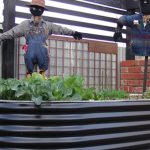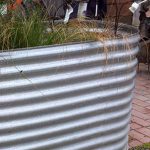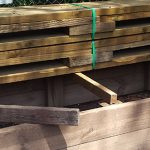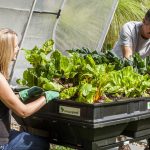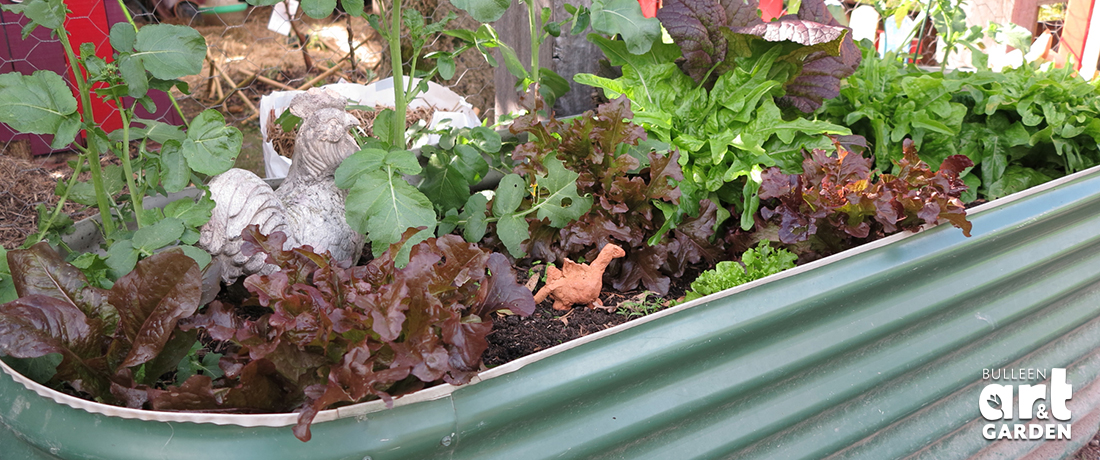
Understanding Wicking Beds
For any gardeners who have used self-watering pots, you are already familiar with sub-irrigation systems. If you’ve ever sat a pot plant in a saucer of water on a hot summer day, that’s sub-irrigation, and that’s exactly how a wicking bed works, the only difference being that it can be scaled up to the size of a whole raised garden bed!
Wicking beds appear to be very promising, so you may be wondering why they aren’t more widespread, and why the sub-irrigation systems aren’t more universally adopted in the gardening world. The simple answer is that wicking beds and sub-irrigation systems are not a universal solution to all watering problems, and that different plants have different watering needs.
Wicking beds create very unique soil conditions because water wicks up from below the plant roots upwards to the top of the soil, and this system has very clear advantages and disadvantages, which we will examine below.
The Advantages of Wicking Beds
Infrequent watering – wicking beds contain a water reservoir below the soil made from PVC or rubber pond liner, which holds a lot of water that slowly wicks up to keep the soil moist. They are great for school gardens where nobody is present to water the garden over the summer holidays when the weather is at its hottest, or for low maintenance garden beds in community gardens or verge plantings
Gardening under trees with invasive roots – Eucalypts and other big trees with invasive roots can suck every last drop of moisture out of the soil, making the surrounding area unsuitable for garden beds. Since wicking beds are sealed systems they cannot be invaded by tree roots, making gardening possible in areas that would normally be too hostile for general gardening.
Height – raised beds in general, including wicking beds, are more suitable for elderly gardeners who have trouble bending over or reaching into garden beds on the ground. In terms of ergonomics, the garden bed can be easily accessed from all sides with minimum effort.
The Disadvantages of Wicking Beds
Constant moisture – many, if not most, plants require a wet-dry cycle – they dislike constantly moist soil. The soil at the bottom of a wicking bed is wet, and gets progressively drier as you move upward to the soil surface. The water-saturated soil at the very bottom (known as the perched water table) does not drain and very quickly becomes a muddy, foul-smelling anaerobic sludge (I know this because I’m one of the few people in the gardening world who has ever had to dismantle a well-maintained wicking bed). If you’re growing plants that love constantly moist soil, they will love the environment in a wicking bed, but plants that are adapted to drier conditions possibly won’t be as happy.
Limited Root Depth – the plants in a wicking bed need a certain level of moisture, as they do in any garden bed or container. Since the soil in a wicking bed wicks moisture from the water reservoir below, the water can only wick up to a certain height through the forces of capillary action, cohesion and adhesion against the forces of gravity.
The result is that deep-rooted plants will have access to the very wet soil at the bottom, and the shallower rooted plants may not be able to reach the moisture if their roots don’t run deep enough, such as in the case of young vegetable seedlings. As well, deeper-rooted plants will run into issues if they don’t like ‘wet feet’ (constantly wet roots). Most vegetables have around 80% of their roots in the first 30cm of soil so they will survive well in shallow garden beds; deeper rooted perennials, cane berries, larger shrubs and small trees are not suited to the soil environment created by a wicking bed.
High Salt Concentrations – the last but most significant issue with wicking beds is the issue of rising salts in the soil and high salt concentrations in the water reservoir. All water contains dissolved salts – that’s what the scale on the inside of your kettle is – and as the water evaporates, the salts are left behind, leaving that characteristic white, crusty residue. In a wicking bed, plants take up some of the water and some evaporates. As water evaporates, the concentration of salts increases. With any plants, if the concentration of salts in the soil is high enough, water will be drawn out of the plant roots by osmosis, depriving the plant of water and ‘burning the roots.’ Also, as water wicks upwards to the surface to evaporate, it carries the salts upwards, so the salt concentration gradually becomes highest at the top of the soil, where shallow rooted seedlings will be planted. This phenomenon is commonly seen in self-watering pots where white salt deposits form around the rim and the soil surface.
Fertiliser Overload – Another critical point is the use of fertiliser. In garden beds and containers, fertiliser naturally drains away from the plant roots, which is why we need to keep adding it. In a wicking bed the levels of fertiliser just keep building up in the water reservoir, so it is important to use less fertiliser in such a system and to flush out the whole system from the top to wash out the rising salts and build-up of fertiliser through the overflow outlet, and to prevent the proliferation of any anaerobic pathogens in the muddy soil.
Cost of Materials – wicking beds are never a cheap option. Only use a raised bed if you need a raised bed, and only use a wicking bed if a raised bed will not suffice. The cost of materials is NOT cheap, and if you’re an organic gardener, you might not be keen on using the cheaper PVC lining and PVC pipes (which leach phthalates, hence the reason why PVC is NOT used in food grade plastics) and you might want to resort to the more expensive butyl rubber pond lining, and use a safer substitute for the PVC pipes.
In Summary
Wicking beds are a great innovation for gardening where very little attention is given to a garden and frequent watering is not possible. Due to the constantly moist soil conditions and a lack of a wet-dry cycle, wicking beds are more suitable for growing annual vegetables, and perform well as community garden or school vegetable garden beds. In terms of maintenance, it is necessary to flush out wicking beds at least once a year, especially if they are not exposed to rainfall. They can hold a fair bit of water – a 1m x 2m wicking bed with a 20cm deep water reservoir will hold at least 200 litres of water in the scoria layer below the soil, so there is a lot of water to flush out! While not a universal solution to every style of gardening, wicking beds do have their place in the gardening world and offer possibilities in difficult locations.

